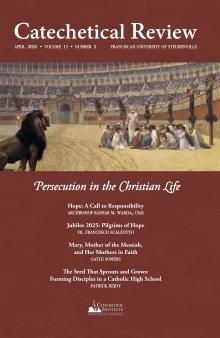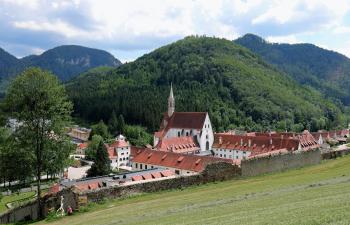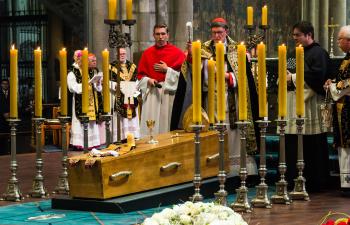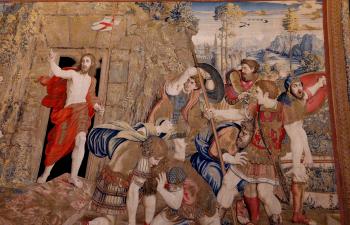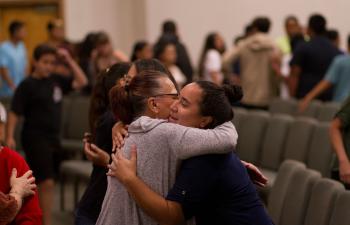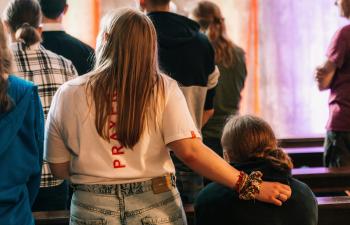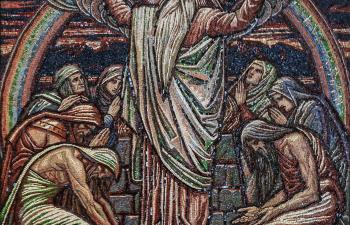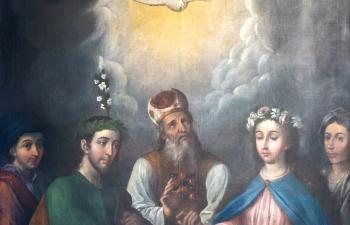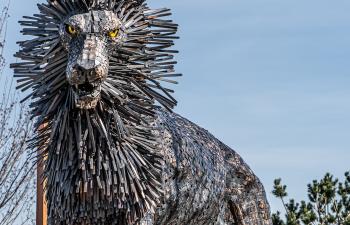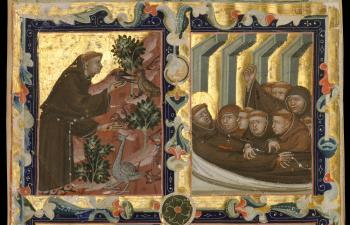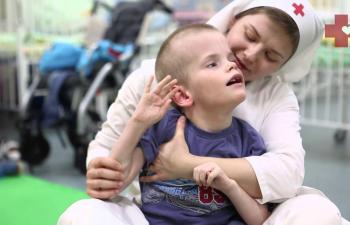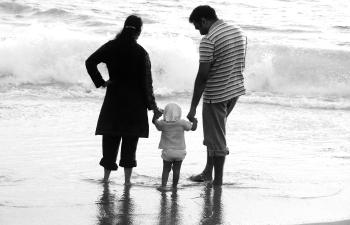 From the earliest years of Christian history, the Church referred to the Blessed Virgin Mary as the New Eve. For example, in about 180 A.D., St. Irenaeus wrote that “The knot of Eve’s disobedience was loosed by the obedience of Mary.”[1] Many of the Early Church Fathers who came after him continued this tradition of beginning in the Old Testament with Eve to teach about Mary. Why did they start there instead of the New Testament? Why must we, too, start there?
From the earliest years of Christian history, the Church referred to the Blessed Virgin Mary as the New Eve. For example, in about 180 A.D., St. Irenaeus wrote that “The knot of Eve’s disobedience was loosed by the obedience of Mary.”[1] Many of the Early Church Fathers who came after him continued this tradition of beginning in the Old Testament with Eve to teach about Mary. Why did they start there instead of the New Testament? Why must we, too, start there?
Starting in the Right Place
I spent many years as an evangelical Protestant before I became a Catholic. Even though I had a great love of Scripture and taught many Bible studies, I never really “saw” Mary in the New Testament. I knew she was an important part of Jesus’ story, of course, but because of her few recorded words and appearances, I simply never gave her much thought. To me, it seemed impossible to arrive at Catholic teaching about Mary from the scant references we find about her in the New Testament. I chalked up her exalted role in Catholic teaching to sentimentality. All of us love our mothers. Catholics love the mother of Jesus. I left it at that.
When I had cause to think about the claims of the Catholic Church, I noticed right away that the Church has always begun in the Old Testament to explain Mary. The early chapters of Genesis tell us that “In the beginning,” God created male and female to be the flesh and blood fullness of his image and likeness on earth (see Gn 1:1; 1:26–27). When they fell, God’s response to their disobedience was to curse his enemy, the serpent, who was the real culprit in that drama. He vowed to send another man and woman, a mother and her Son, to victoriously finish the battle begun in Eden (see Gn 3:15). This makes perfect sense! If, from the beginning, God intended the masculine and the feminine, together, to be the icons of his image and likeness in creation, then we should expect to find both a man and a woman to herald the start of his re-creation after the Fall. Mary’s role in the Church’s teaching is theological, not sentimental. I finally had eyes to see this, and it changed everything for me.
Staying in the Right Place
If we begin in the Old Testament’s first book, Genesis, to understand God’s promise to send a mother and Son for our rescue, shouldn’t we stay in the Old Testament to find out more about them? Yes, and that is exactly what the Church does by teaching us to learn from the “types” of both Jesus and Mary there. Types are real people whose lives foreshadow the mother and Son for whom creation waited. The Catechism of the Catholic Church tells us: “Throughout the Old Covenant the mission of many holy women prepared for that of Mary” (489). Most of us are very familiar with the types of Jesus in the Old Testament—Adam, Moses, David, Solomon, etc. We regularly hear about them in lectionary readings. Are we as familiar with the Old Testament types of Mary?
Certainly, Mary would have been very familiar with these women. As a devout Jewish girl, she heard their stories all through her life. Jewish parents took special care to teach the Scriptures to their children (see 2 Tm 3:15). We know that Jesus immersed himself in the words of Scripture before and during his public ministry. Even as a boy of 12, he astounded those who heard him in the Jerusalem Temple. What were they discussing? The Scriptures, of course, because that is what Jews did in the Temple and synagogues in Jesus’ time (and beyond). On Mary’s formation for her work in redemption St. John Paul II has written: “Although his mother introduced Jesus to the culture and traditions of the people of Israel, from the time of his finding in the Temple, he would reveal his full awareness of being the Son of God [to her]. . . . From being her Son’s ‘teacher,’ Mary thus became the humble disciple of the divine Master to whom she had given birth.”[2]
Mary’s Mothers in Faith
I led a home Bible study several years ago on the women of the Old Testament. By its end, the women in that study were amazed to discover how many wonderful Old Testament women of faith “whisper” of Mary. That is, in each woman’s story, there was always at least one moment that was somehow familiar to us from Mary’s life. It did not take long for us to recognize a pattern in these stories. We began to think of each woman as a tile in what would become the beautiful mosaic of Mary of Nazareth. We could sense the anticipation building for that woman whom God promised in Genesis. When she appeared, what should we look for in the mother of the Messiah? Some examples will show what we discovered.
Eve is perhaps the best-known type of Mary, but her importance in the story of salvation goes far beyond her disobedience in eating the forbidden fruit. Eve, a woman, stood at the center of the first great drama in human history. When the fallen angel appears as a serpent in Eden, all eyes are on Eve. The fate of all who came after her hinged on her response to that dark angelic presence. Surely this reveals the importance of the feminine in God’s created order. Although Eve was created as a helper to Adam, who was in charge of the Garden (see Gn 2:15–16, 20–23 ), she was the first target of God’s enemy, not Adam (see Gn 3:1). We know that Eve chose badly, but that should not blind us to the fact that our human story started with a woman entrusted with a life-and-death decision upon which God’s people would depend. When in the New Testament we meet Mary of Nazareth as she is visited by the angel Gabriel (see Lk 1:26–27), we recognize that, once again, a woman stands at the center of what will become the re-creation of God’s world. All of human history would depend on her response. Jesus accomplished God’s plan of redemption for us, but Mary appears as his helper, a role given to her by God, just as he promised in Eden.
In the Old Testament history of God’s people, we should expect to find examples of women who, although not in charge of shaping much of it, will make vital contributions to God’s plan of salvation as helpers of various kinds. We should also expect that as Eve foreshadowed Mary, these women will, too.
That is exactly what we find. There is Miriam, the sister of Moses and Aaron, who helped them deliver God’s people from slavery in Egypt (see Mi 6:4 ). After they escaped through the waters of the Red Sea, finally free from bondage, Moses and Miriam led the Israelites in a song of thankful praise at the water’s edge (see Ex 15:20–21). Miriam was the first woman in Scripture to burst into a prayer song over God’s miraculous work for his people. She began what became a long line of women who raised their voices in the same way to sing’s God’s praises—Deborah (see Jgs 5 ), Hannah (see 1 Sm 2:1–10), and Judith (see Jth 16:1–17) also stood in that line. In the New Testament, Mary of Nazareth continued that tradition in her beautiful prayer song, the Magnificat (see Lk 1:46–55), a song we are still singing today.
In Deborah, we see the only woman to serve as a judge in Israel before there was a king (see Jgs 4:4–5). God told her to announce to Barak, the commander of Israel’s ragtag army, that he was to go into battle against a powerful enemy and, against all odds, to expect victory. Barak insisted Deborah accompany him. She did, but she served as a helper without ever lifting a sword. She shouted encouragement to the army to fight with confidence in God: “Up! For this is the day in which the LORD has given Sisera [the enemy commander] into your hand. Does not the LORD go out before you?” (Jgs 4:14). Her heroic role gained for her the title of “a mother in Israel” (Jgs 5:7). To appreciate the beauty of Marian typology in Deborah, we must remember that at the time of the Fall God promised to send a woman who would be both a mother and a warrior. She and her Son would do battle against God’s enemy, the devil, and win. Mary, like Deborah, served as a helper to the commander, Jesus, in the battle that began the moment Mary spoke her fiat to Gabriel’s announcement. She, like Deborah, is a mother and a warrior in the Church, the new Israel.
Finally, there was Judith, who lived during the time when the Jews had returned to the Promised Land after their exile in Babylon. Although she was a rich, young, and beautiful widow, she lived a quiet, simple, ascetic life on the roof of her house (see Jth 8:5–6). When an enemy army threatened the town where she lived, the elders wanted to surrender to survive. Judith knew this was not what God wanted for his covenant people. She exhorted them to call upon God for help and to resist the enemy. They refused, so she hatched her own plan to defeat the enemy, relying solely on God’s trustworthiness. She succeeded in penetrating the enemy camp—not with arms but with a goodness that made her dazzlingly beautiful (see Jth 8:7–8). She finally made it into the commander’s tent—not by her manipulation but by his lust for her (Jth 12:12). He fell into drunken sleep. Judith, crying out to God for help in this crucial moment, beheaded the commander, Holofernes, with his own sword (see Jth 13:2–8). She returned to her town announcing the good news, and she urged the army to go into battle. Without their leader, the soldiers were sure to flee in every direction. The Jews followed her direction and soundly defeated the enemy. Everyone was shocked that a woman could be victorious over a such a powerful threat. There was great rejoicing among the people and loud acclamations over Judith’s heroic faith and bravery, as when the town elder, Uzziah, cried out, “O daughter, you are blessed by the Most High God above all women on earth” (see Jth 13:18). However, she returned to her humble, simple life after it was all accomplished (see Jth 16:21–25).
Judith—humble, simple, beautiful with virtuous goodness—crushed the head of Israel’s terrifying enemy, paving the way for Israel’s victory. Mary—humble, simple, beautiful with the fullness of grace—worked with Jesus to fulfill God’s promise in Eden. The woman and her Son would deliver a fatal head wound to God’s enemy. Mary had many heroic moments in her life, both before and after Jesus was born. Through them all she remained small, quiet, and given to pondering. Judith’s story prepares us for just such a mother of the Messiah.
Old Testament Women, Our Mothers in Faith
When we finished our Bible study on Old Testament women, the ladies urged me to write a book so they could reread it and pass it along to their daughters and granddaughters. So that is what I did. The book is Whispers of Mary: What Twelve Old Testament Women Teach Us About Mary (Ascension Press). It helps us see and appreciate Marian typology in the Old Testament. It is also full of the wonderful life lessons of faith we learned from these Old Testament women—how God used Sarah’s mistakes to deepen her relationship with him, how Rahab had the courage and faith to risk her life to do God’s will, how Esther found joy in her difficult life by living every day trusting God’s goodness. These were treasured lessons for Mary. They can be lessons for us, as well.
[1] Irenaeus, Against Heresies 3.22, trans. Alexander Roberts and William Rambaut, in Ante-Nicene Fathers, vol. 1, ed. Alexander Roberts, James Donaldson, and A. Cleveland Coxe (Christian Literature Publishing, 1885), rev. and ed. for New Advent by Kevin Knight, http://www.newadvent.org/fathers/0103322.htm.
[2] John Paul II, Theotokos: Woman, Mother, Disciple: A Catechesis on Mary, Mother of God (Pauline Books and Media, 2000), 154.
Art Credit: The tree of death and of life by Berthold Furtmeyr, The Salzburg Missal Vol. 3 (15th century), München, Bayerische Staatsbibliothek, CC.
This article is from The Catechetical Review (Online Edition ISSN 2379-6324) and may be copied for catechetical purposes only. It may not be reprinted in another published work without the permission of The Catechetical Review by contacting [email protected]



